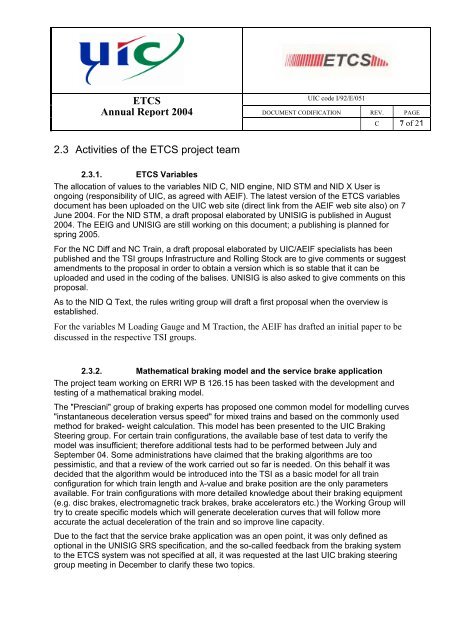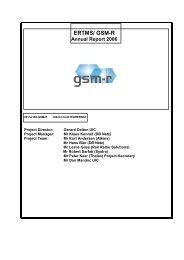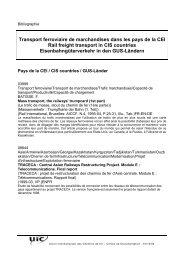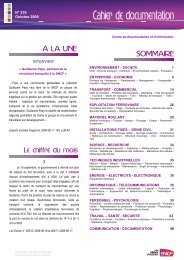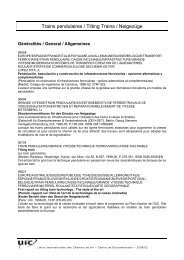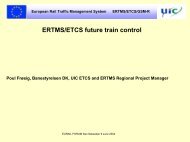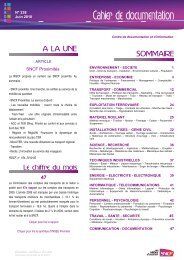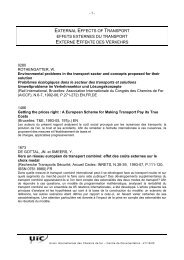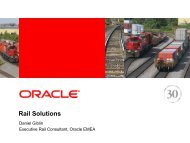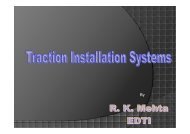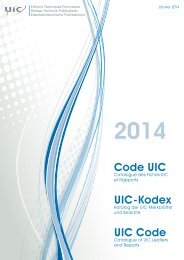UIC Project Annual Report - ERTMS
UIC Project Annual Report - ERTMS
UIC Project Annual Report - ERTMS
- No tags were found...
Create successful ePaper yourself
Turn your PDF publications into a flip-book with our unique Google optimized e-Paper software.
ETCS<strong>UIC</strong> code I/92/E/051<strong>Annual</strong> <strong>Report</strong> 2004 DOCUMENT CODIFICATION REV. PAGEC 7 of 212.3 Activities of the ETCS project team2.3.1. ETCS VariablesThe allocation of values to the variables NID C, NID engine, NID STM and NID X User isongoing (responsibility of <strong>UIC</strong>, as agreed with AEIF). The latest version of the ETCS variablesdocument has been uploaded on the <strong>UIC</strong> web site (direct link from the AEIF web site also) on 7June 2004. For the NID STM, a draft proposal elaborated by UNISIG is published in August2004. The EEIG and UNISIG are still working on this document; a publishing is planned forspring 2005.For the NC Diff and NC Train, a draft proposal elaborated by <strong>UIC</strong>/AEIF specialists has beenpublished and the TSI groups Infrastructure and Rolling Stock are to give comments or suggestamendments to the proposal in order to obtain a version which is so stable that it can beuploaded and used in the coding of the balises. UNISIG is also asked to give comments on thisproposal.As to the NID Q Text, the rules writing group will draft a first proposal when the overview isestablished.For the variables M Loading Gauge and M Traction, the AEIF has drafted an initial paper to bediscussed in the respective TSI groups.2.3.2. Mathematical braking model and the service brake applicationThe project team working on ERRI WP B 126.15 has been tasked with the development andtesting of a mathematical braking model.The "Presciani" group of braking experts has proposed one common model for modelling curves"instantaneous deceleration versus speed" for mixed trains and based on the commonly usedmethod for braked- weight calculation. This model has been presented to the <strong>UIC</strong> BrakingSteering group. For certain train configurations, the available base of test data to verify themodel was insufficient; therefore additional tests had to be performed between July andSeptember 04. Some administrations have claimed that the braking algorithms are toopessimistic, and that a review of the work carried out so far is needed. On this behalf it wasdecided that the algorithm would be introduced into the TSI as a basic model for all trainconfiguration for which train length and λ-value and brake position are the only parametersavailable. For train configurations with more detailed knowledge about their braking equipment(e.g. disc brakes, electromagnetic track brakes, brake accelerators etc.) the Working Group willtry to create specific models which will generate deceleration curves that will follow moreaccurate the actual deceleration of the train and so improve line capacity.Due to the fact that the service brake application was an open point, it was only defined asoptional in the UNISIG SRS specification, and the so-called feedback from the braking systemto the ETCS system was not specified at all, it was requested at the last <strong>UIC</strong> braking steeringgroup meeting in December to clarify these two topics.


